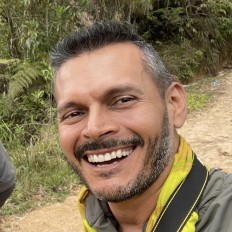Top species
- Pheasant Cuckoo (Dromococcyx phasianellus)
- Black-bellied Cuckoo (Piaya melanogaster)
- Tawny-bellied Screech-Owl (Megascops watsonii)
- Orange-cheeked Parrot (Pyrilia barrabandi)
- Cocha Antshrike (Thamnophilus praecox)
- Pearly Antshrike (Megastictus margaritatus)
- Plumbeous Antbird (Myrmelastes hyperythrus)
- Blue-backed Manakin (Chiroxiphia pareola)
- Black-necked Red-Cotinga (Phoenicircus nigricollis)
- Screaming Piha (Lipaugus vociferans)
- Euler's Flycatcher (Lathrotriccus euleri)
- Drab Water Tyrant (Ochthornis littoralis)
- Lawrence's Thrush (Turdus lawrencii)
List up to ca. 25 species that:
• have a limited distribution range and/or are rare on a global level
• are most sought-after by birdwatchers at this site
• and are relatively easy to see at this site (year-round or seasonally)
| Pheasant Cuckoo (Dromococcyx phasianellus) | |
| Black-bellied Cuckoo (Piaya melanogaster) | |
| Tawny-bellied Screech-Owl (Megascops watsonii) | |
| Orange-cheeked Parrot (Pyrilia barrabandi) | |
| Cocha Antshrike (Thamnophilus praecox) | |
| Pearly Antshrike (Megastictus margaritatus) | |
| Plumbeous Antbird (Myrmelastes hyperythrus) | |
| Blue-backed Manakin (Chiroxiphia pareola) | |
| Black-necked Red-Cotinga (Phoenicircus nigricollis) | |
| Screaming Piha (Lipaugus vociferans) | |
| Euler's Flycatcher (Lathrotriccus euleri) | |
| Drab Water Tyrant (Ochthornis littoralis) | |
| Lawrence's Thrush (Turdus lawrencii) |
Pheasant Cuckoo (Dromococcyx phasianellus) was added by Jorge Muñoz García (2022-05-12 01:10:24)
Screaming Piha (Lipaugus vociferans) was added by Jorge Muñoz García (2022-05-12 00:54:41)
Blue-backed Manakin (Chiroxiphia pareola) was added by Jorge Muñoz García (2022-05-12 00:51:26)
Drab Water Tyrant (Ochthornis littoralis) was added by Jorge Muñoz García (2022-05-12 00:50:26)
Black-bellied Cuckoo (Piaya melanogaster) was added by Jorge Muñoz García (2022-05-12 00:49:19)
Orange-cheeked Parrot (Pyrilia barrabandi) was added by Jorge Muñoz García (2022-05-12 00:48:58)
Lawrence's Thrush (Turdus lawrencii) was added by Jorge Muñoz García (2022-05-12 00:43:29)
Tawny-bellied Screech-Owl (Megascops watsonii) was added by Jorge Muñoz García (2022-05-12 00:42:56)
Pearly Antshrike (Megastictus margaritatus) was added by Jorge Muñoz García (2022-05-12 00:42:33)
Euler's Flycatcher (Lathrotriccus euleri) was added by Jorge Muñoz García (2022-05-12 00:42:16)
Plumbeous Antbird (Myrmelastes hyperythrus) was added by Jorge Muñoz García (2022-05-12 00:41:00)
Cocha Antshrike (Thamnophilus praecox) was added by Jorge Muñoz García (2022-05-12 00:40:40)
Black-necked Red-Cotinga (Phoenicircus nigricollis) was added by Jorge Muñoz García (2022-05-12 00:39:24)


